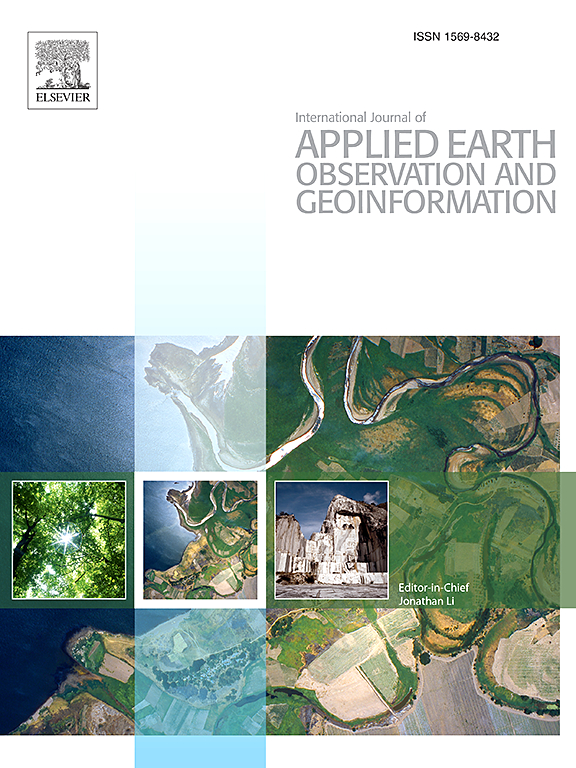Integrating RS data with fuzzy decision systems for innovative crop water needs assessment
IF 7.6
Q1 REMOTE SENSING
International journal of applied earth observation and geoinformation : ITC journal
Pub Date : 2025-02-01
DOI:10.1016/j.jag.2024.104338
引用次数: 0
Abstract
Irrigation is a critical component of global water usage, accounting for approximately 70 % of water consumption. As the world’s population continues to grow, the demand for food will increase, making it essential to improve irrigation management by reducing water waste and increasing efficiency. This study aims to develop and validate a fuzzy decision-making system that determines crop irrigation needs based on parameters that affect plant water requirements. These parameters can be monitored using Remote sensing (RS) satellites, enabling large-scale agricultural irrigation monitoring. The study utilized Landsat-8 satellite data and meteorological data. It also employed a fuzzy decision system with inputs of estimated evapotranspiration, Normalized Difference Vegetation Index (NDVI), Leaf Area Index (LAI), Land Surface Temperature (LST), Crop Water Stress Index (CWSI), Stress Index (SI), and Soil Moisture (SM). The output of the fuzzy model is a map that effectively determines the irrigation requirements for agricultural land relatively. The system was tested on six Landsat images of winter wheat crops in Tehran University’s agricultural fields. The estimated evapotranspiration was compared to Reference Evapotranspiration (ETr) obtained from the FAO-Penman-Monteith equation, resulting in a root mean square error of 0.33 mm. The fuzzy decision system was evaluated by comparing its results with Vegetation Water Content (VWC) measurements during satellite overpass time. The NDVI, CWSI, SI, and SM variables had the highest R2 with VWC data (0.71––0.92) on all six dates. This approach has significant implications for improving irrigation management practices, reducing water waste, and increasing crop yields, which can contribute to global food security. The study highlights the potential of RS technology and fuzzy decision-making systems in promoting sustainable agriculture.

遥感数据与模糊决策系统相结合的创新作物需水量评价
灌溉是全球用水的重要组成部分,约占用水量的70%。随着世界人口的持续增长,对粮食的需求将会增加,因此必须通过减少水浪费和提高效率来改善灌溉管理。本研究旨在开发并验证一个模糊决策系统,该系统可以根据影响植物需水量的参数来确定作物的灌溉需求。这些参数可以利用遥感卫星进行监测,从而实现大规模的农业灌溉监测。该研究利用了Landsat-8卫星数据和气象数据。采用模糊决策系统,以估算蒸散量、归一化植被指数(NDVI)、叶面积指数(LAI)、地表温度(LST)、作物水分胁迫指数(CWSI)、胁迫指数(SI)和土壤湿度(SM)为输入。模糊模型的输出是一幅能有效确定农业用地相对灌溉需求的图。该系统在德黑兰大学农田的六张冬小麦作物的Landsat图像上进行了测试。将估算的蒸散发量与FAO-Penman-Monteith方程获得的参考蒸散发量(ETr)进行比较,结果均方根误差为0.33 mm。通过与卫星立交桥时间植被含水率(VWC)测量结果的比较,对模糊决策系统进行了评价。NDVI、CWSI、SI和SM变量与VWC数据的R2均最高(0.71—0.92)。这种方法对改善灌溉管理做法、减少水浪费和提高作物产量具有重要意义,从而有助于全球粮食安全。该研究强调了遥感技术和模糊决策系统在促进可持续农业方面的潜力。
本文章由计算机程序翻译,如有差异,请以英文原文为准。
求助全文
约1分钟内获得全文
求助全文
来源期刊

International journal of applied earth observation and geoinformation : ITC journal
Global and Planetary Change, Management, Monitoring, Policy and Law, Earth-Surface Processes, Computers in Earth Sciences
CiteScore
12.00
自引率
0.00%
发文量
0
审稿时长
77 days
期刊介绍:
The International Journal of Applied Earth Observation and Geoinformation publishes original papers that utilize earth observation data for natural resource and environmental inventory and management. These data primarily originate from remote sensing platforms, including satellites and aircraft, supplemented by surface and subsurface measurements. Addressing natural resources such as forests, agricultural land, soils, and water, as well as environmental concerns like biodiversity, land degradation, and hazards, the journal explores conceptual and data-driven approaches. It covers geoinformation themes like capturing, databasing, visualization, interpretation, data quality, and spatial uncertainty.
 求助内容:
求助内容: 应助结果提醒方式:
应助结果提醒方式:


